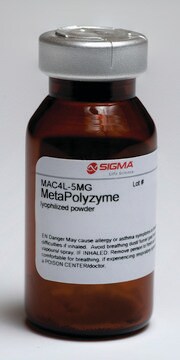SML2430
Kdo2-Lipid A (KLA)
≥90% (HPLC)
Synonym(e):
Di[3-deoxy-D-manno-octulosonyl]-lipid A (ammonium salt), KLA, Kdo2-LipidA
About This Item
Empfohlene Produkte
Biologische Quelle
Escherichia coli
Assay
≥90% (HPLC)
Form
solid
Lagertemp.
−20°C
SMILES String
O=C(O)[C@@]1(O[C@H]2[C@@H](O)C([C@H](O)CO)O[C@](C(O)=O)(OC[C@H]3O[C@@H](OC[C@H]4O[C@H](OP(O)(O)=O)[C@@H](NC(C[C@@H](CCCCCCCCCCC)O)=O)C(OC(C[C@@H](CCCCCCCCCCC)O)=O)[C@H]4O)C(NC(C[C@@H](CCCCCCCCCCC)OC(CCCCCCCCCCC)=O)=O)[C@@H](OC(C[C@@H](CCCCCCCCCCC)OC(CCCCC
Verwandte Kategorien
Allgemeine Beschreibung
Sonstige Hinweise
Lagerklassenschlüssel
11 - Combustible Solids
WGK
WGK 3
Flammpunkt (°F)
No data available
Flammpunkt (°C)
No data available
Analysenzertifikate (COA)
Suchen Sie nach Analysenzertifikate (COA), indem Sie die Lot-/Chargennummer des Produkts eingeben. Lot- und Chargennummern sind auf dem Produktetikett hinter den Wörtern ‘Lot’ oder ‘Batch’ (Lot oder Charge) zu finden.
Besitzen Sie dieses Produkt bereits?
In der Dokumentenbibliothek finden Sie die Dokumentation zu den Produkten, die Sie kürzlich erworben haben.
Kunden haben sich ebenfalls angesehen
Unser Team von Wissenschaftlern verfügt über Erfahrung in allen Forschungsbereichen einschließlich Life Science, Materialwissenschaften, chemischer Synthese, Chromatographie, Analytik und vielen mehr..
Setzen Sie sich mit dem technischen Dienst in Verbindung.








